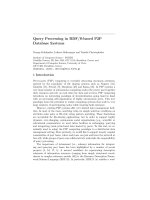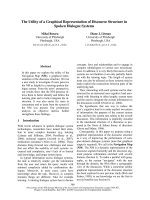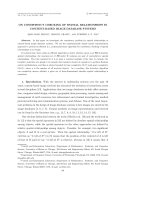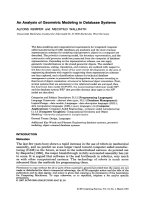Inclusion of new types in relational database systems
Bạn đang xem bản rút gọn của tài liệu. Xem và tải ngay bản đầy đủ của tài liệu tại đây (53.77 KB, 19 trang )
INCLUSION OF NEW TYPES IN RELATIONAL
DATA BASE SYSTEMS
Michael Stonebraker
EECS Dept.
University of California, Berkeley
Abstract
This paper explores a mechanism to support user-defined data types for columns in a relational data
base system. Previous work suggested how to support new operators and new data types. The contribution
of this work is to suggest ways to allow query optimization on commands which include new data types
and operators and ways to allow access methods to be used for new data types.
1. INTRODUCTION
The collection of built-in data types in a data base system (e.g. integer, floating point number, char-
acter string) and built-in operators (e.g. +, -, *, /) were motivated by the needs of business data processing
applications. However, in many engineering applications this collection of types is not appropriate. For
example, in a geographic application a user typically wants points, lines, line groups and polygons as basic
data types and operators which include intersection, distance and containment. In scientific application,
one requires complex numbers and time series with appropriate operators. In such applications one is
currently required to simulate these data types and operators using the basic data types and operators pro-
vided by the DBMS at substantial inefficiency and complexity. Even in business applications, one some-
times needs user-defined data types. For example, one system [RTI84] has implemented a sophisticated
date and time data type to add to its basic collection. This implementation allows subtraction of dates, and
returns "correct" answers, e.g.
"April 15" - "March 15" = 31 days
This definition of subtraction is appropriate for most users; however, some applications require all months
to have 30 days (e.g. programs which compute interest on bonds). Hence, they require a definition of sub-
This research was sponsored by the U.S. Air Force Office of Scientific Research Grant 83-0254 and the Naval Electronics Sys-
tems Command Contract N39-82-C-0235
traction which yields 30 days as the answer to the above computation. Only a user-defined data type facil-
ity allows such customization to occur.
Current data base systems implement hashing and B-trees as fast access paths for built-in data types.
Some user-defined data types (e.g. date and time) can use existing access methods (if certain extensions are
made); however other data types (e.g. polygons) require new access methods. For example R-trees
[GUTM84], KDB trees [ROBI81] and Grid files are appropriate for spatial objects. In addition, the intro-
duction of new access methods for conventional business applications (e.g. extendible hashing [FAGI79,
LITW80]) would be expeditied by a facility to add new access methods.
A complete extended type system should allow:
1) the definition of user-defined data types
2) the definition of new operators for these data types
3) the implementation of new access methods for data types
4) optimized query processing for commands containing new data types and operators
The solution to requirements 1 and 2 was described in [STON83]; in this paper we present a complete pro-
posal. In Section 2 we begin by presenting a motivating example of the need for new data types, and then
briefly review our earlier proposal and comment on its implementation. Section 3 turns to the definition of
new access methods and suggests mechanisms to allow the designer of a new data type to use access
methods written for another data type and to implement his own access methods with as little work as pos-
sible. Then Section 4 concludes by showing how query optimization can be automatically performed in
this extended environment.
2. ABSTRACT DATA TYPES
2.1. A Motivating Example
Consider a relation consisting of data on two dimensional boxes. If each box has an identifier, then it
can be represented by the coordinates of two corner points as follows:
create box (id = i4, x1 = f8, x2 = f8, y1 = f8, y2 = f8)
Now consider a simple query to find all the boxes that overlap the unit square, ie. the box with coordinates
(0, 1, 0, 1). The following is a compact representation of this request in QUEL:
2
retrieve (box.all) where not
(box.x2 <= 0 or box.x1 >= 1 or box.y2 <= 0 or box.y1 >= 1)
The problems with this representation are:
The command is too hard to understand.
The command is too slow because the query planner will not be able to optimize some-
thing this complex.
The command is too slow because there are too many clauses to check.
The solution to these difficulties is to support a box data type whereby the box relation can be
defined as:
create box (id = i4, desc = box)
and the resulting user query is:
retrieve (box.all) where box.desc !! "0, 1, 0, 1"
Here "!!" is an overlaps operator with two operands of data type box which returns a boolean. One would
want a substantial collection of operators for user defined types. For example, Table 1 lists a collection of
useful operators for the box data type.
Fast access paths must be supported for queries with qualifications utilizing new data types and
operators. Consequently, current access methods must be extended to operate in this environment. For
example, a reasonable collating sequence for boxes would be on ascending area, and a B-tree storage struc-
ture could be built for boxes using this sequence. Hence, queries such as
retrieve (box.all) where box.desc AE "0,5,0,5"
should use this index. Moreover, if a user wishes to optimize access for the !! operator, then an R-tree
[GUTM84] may be a reasonable access path. Hence, it should be possible to add a user defined access
method. Lastly, a user may submit a query to find all pairs of boxes which overlap, e.g:
range of b1 is box
range of b2 is box
retrieve (b1.all, b2.all) where b1.desc !! b2.desc
A query optimizer must be able to construct an access plan for solving queries which contains user defined
operators.
3
Binary operator symbol left operand right operand result
overlaps !! box box boolean
contained in << box box boolean
is to the left of <L box box boolean
is to the right of >R box box boolean
intersection ?? box box box
distance " box box float
area less than AL box box boolean
area equals AE box box boolean
area greater AG box box boolean
Unary operator symbol operand result
area AA box float
length LL box float
height HH box float
diagonal DD box line
Operators for Boxes
Table 1
We turn now to a review of the prototype presented in [STON83] which supports some of the above
function.
2.2. DEFINITION OF NEW TYPES
To define a new type, a user must follow a registration process which indicates the existence of the
new type, gives the length of its internal representation and provides input and output conversion routines,
e.g:
define type-name length = value,
input = file-name
output = file-name
The new data type must occupy a fixed amount of space, since only fixed length data is allowed by the
built-in access methods in INGRES. Moreover, whenever new values are input from a program or output
to a user, a conversion routine must be called. This routine must convert from character string to the new
type and back. A data base system calls such routines for built-in data types (e.g. ascii-to-int, int-to-ascii)
4
and they must be provided for user-defined data types. The input conversion routine must accept a pointer
to a value of type character string and return a pointer to a value of the new data type. The output routine
must perform the converse transformation.
Then, zero or more operators can be implemented for the new type. Each can be defined with the
following syntax:
define operator token = value,
left-operand = type-name,
right-operand = type-name,
result = type-name,
precedence-level like operator-2,
file = file-name
For example:
define operator token = !!,
left-operand = box,
right-operand = box,
result = boolean,
precedence like *,
file = /usr/foobar
All fields are self explanatory except the precedence level which is required when several user defined
operators are present and precedence must be established among them. The file /usr/foobar indicates the
location of a procedure which can accept two operands of type box and return true if they overlap. This
procedure is written in a general purpose programming language and is linked into the run-time system and
called as appropriate during query processing.
2.3. Comments on the Prototype
The above constructs have been implemented in the University of California version of INGRES
[STON76]. Modest changes were required to the parser and a dynamic loader was built to load the
required user-defined routines on demand into the INGRES address space. The system was described in
[ONG84].
Our initial experience with the system is that dynamic linking is not preferable to static linking. One
problem is that initial loading of routines is slow. Also, the ADT routines must be loaded into data space to
preserve sharability of the DBMS code segment. This capability requires the construction of a non-trivial
loader. An "industrial strength" implementation might choose to specify the user types which an
5
installation wants at the time the DBMS is installed. In this case, all routines could be linked into the run
time system at system installation time by the linker provided by the operating system. Of course, a data
base system implemented as a single server process with internal multitasking would not be subject to any
code sharing difficulties, and a dynamic loading solution might be reconsidered.
An added difficulty with ADT routines is that they provide a serious safety loophole. For example, if
an ADT routine has an error, it can easily crash the DBMS by overwriting DBMS data structures acciden-
tally. More seriously, a malicious ADT routine can overwrite the entire data base with zeros. In addition,
it is unclear whether such errors are due to bugs in the user routines or in the DBMS, and finger-pointing
between the DBMS implementor and the ADT implementor is likely to result.
ADT routines can be run in a separate address space to solve both problems, but the performance
penalty is severe. Every procedure call to an ADT operator must be turned into a round trip message to a
separate address space. Alternately, the DBMS can interpret the ADT procedure and guarantee safety, but
only by building a language processor into the run-time system and paying the performance penalty of
interpretation. Lastly, hardware support for protected procedure calls (e.g. as in Multics) would also solve
the problem.
However, on current hardware the prefered solution may be to provide two environments for ADT
procedures. A protected environment would be provided for debugging purposes. When a user was
confident that his routines worked correctly, he could install them in the unprotected DBMS. In this way,
the DBMS implementor could refuse to be concerned unless a bug could be produced in the safe version.
We now turn to extending this environment to support new access methods.
3. NEW ACCESS METHODS
A DBMS should provide a wide variety of access methods, and it should be easy to add new ones.
Hence, our goal in this section is to describe how users can add new access methods that will efficiently
support user-defined data types. In the first subsection we indicate a registration process that allows imple-
mentors of new data types to use access methods written by others. Then, we turn to designing lower level
DBMS interfaces so the access method designer has minimal work to perform. In this section we restrict
our attention to access methods for a single key field. Support for composite keys is a straight forward
6
extension. However, multidimensional access methods that allow efficient retrieval utilizing subsets of the
collection of keys are beyond the scope of this paper.
3.1. Registration of a New Access Method
The basic idea which we exploit is that a properly implemented access method contains only a small
number of procedures that define the characteristics of the access method. Such procedures can be
replaced by others which operate on a different data type and allow the access method to "work" for the
new type. For example, consider a B-tree and the following generic query:
retrieve (target-list) where relation.key OPR value
A B-tree supports fast access if OPR is one of the set:
{=, <, <=, >=, >}
and includes appropriate procedure calls to support these operators for a data type (s). For example, to
search for the record matching a specific key value, one need only descend the B-tree at each level search-
ing for the minimum key whose value exceeds or equals the indicated key. Only calls on the operator "<="
are required with a final call or calls to the routine supporting "=".
Moreover, this collection of operators has the following properties:
P1) key-1 < key-2 and key-2 < key-3 then key-1 < key-3
P2) key-1 < key-2 implies not key-2 < key-1
P3) key-1 < key-2 or key-2 < key-1 or key-1 = key-2
P4) key-1 <= key-2 if key-1 < key-2 or key-1 = key-2
P5) key-1 = key-2 implies key-2 = key-1
P6) key-1 > key-2 if key-2 < key-1
P7) key-1 >= key-2 if key-2 <= key-1
In theory, the procedures which implement these operators can be replaced by any collection of procedures
for new operators that have these properties and the B-tree will "work" correctly. Lastly, the designer of a
B-tree access method may disallow variable length keys. For example, if a binary search of index pages is
performed, then only fixed length keys are possible. Information of this restriction must be available to a
type designer who wishes to use the access method.
The above information must be recorded in a data structure called an access method template.We
propose to store templates in two relations called TEMPLATE-1 and TEMPLATE-2 which would have the
7









